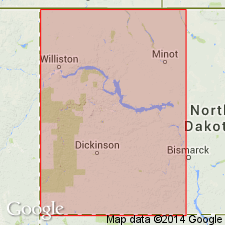
- Usage in publication:
-
- Belfield Member
- Modifications:
-
- Named
- Dominant lithology:
-
- Siltstone
- Redbeds
- Salt
- Shale
- Anhydrite
- AAPG geologic province:
-
- Williston basin
Summary:
Belfield Member, basal member (of 3) of Spearfish Formation. Identified in the subsurface in the central part of the Williston basin, western North Dakota. Formerly called Spearfish Formation (restricted) (Zieglar, 1955), or the lower shale member of Spearfish Formation (Dow, 1964). In the type well consists of gray shale and reddish-orange and light-brown siltstone together with some white and pink anhydrite, traces of dolomite, and some salt in the upper part. Thickness in western North Dakota varies from 0 to 232 feet; is 203 feet thick in type well. Conformably overlies Minnekahta Limestone; conformably underlies either Pine Salt Member or Saude Member. Age is Late Permian based on correlations with beds near the upper part of Goose Egg Formation, Wyoming, and with beds in the lower part of Spearfish Formation in the Black Hills, Wyoming and South Dakota. Report includes isopach map and correlation diagrams.
Type section (subsurface): depth-interval from 7,228 to 7,431 ft, Amerada Petroleum Corp. R.E. Newton No. 1 well, in NW/4 SW/4 sec. 31, T. 140 N., R. 99 W., Stark Co., ND. Named from Belfield, Stark Co., ND, Williston basin.
Source: Modified from GNU records (USGS DDS-6; Denver GNULEX).
For more information, please contact Nancy Stamm, Geologic Names Committee Secretary.
Asterisk (*) indicates published by U.S. Geological Survey authors.
"No current usage" (†) implies that a name has been abandoned or has fallen into disuse. Former usage and, if known, replacement name given in parentheses ( ).
Slash (/) indicates name conflicts with nomenclatural guidelines (CSN, 1933; ACSN, 1961, 1970; NACSN, 1983, 2005, 2021). May be explained within brackets ([ ]).

